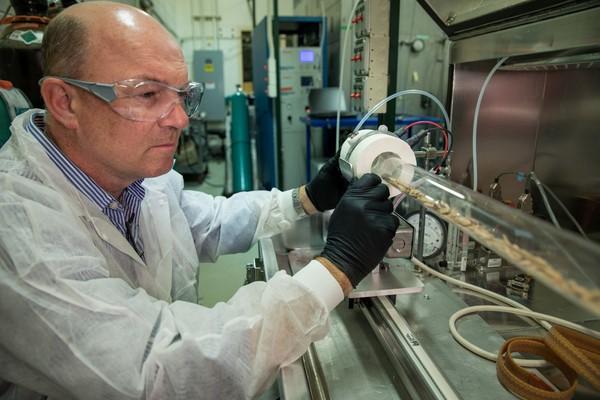Advancing Technology to Study the Toxicity of Wildfire Smoke
Published November 4, 2019
 Dr. Ian Gilmour conducting an experiment using the tube furnace.From the moment a wildfire begins, billows of smoke can travel upward into the atmosphere. The smoke can cause acute and chronic health impacts, especially in small children, the elderly, and people with preexisting respiratory conditions. For people in the path of smoke plumes, firefighters, and even communities further downwind of wildfires, researchers want to know how hazardous these exposures are to human health.
Dr. Ian Gilmour conducting an experiment using the tube furnace.From the moment a wildfire begins, billows of smoke can travel upward into the atmosphere. The smoke can cause acute and chronic health impacts, especially in small children, the elderly, and people with preexisting respiratory conditions. For people in the path of smoke plumes, firefighters, and even communities further downwind of wildfires, researchers want to know how hazardous these exposures are to human health.
In a laboratory in Research Triangle Park, NC, researchers built a tube furnace system to precisely generate different types of smoke to assess how fuel composition and combustion conditions affect the chemistry and subsequent toxicity of biomass smoke. Using this system, they reported that smoke samples injected into mouse lungs caused varying degrees of lung toxicity depending on the type of fuel, or if the fire was under flaming or smoldering conditions [1].
The researchers then went back to the design board and modified the system for use in animal inhalation studies so that the direct effects of smoke on lung function could be measured. The newer 2019 study published by EPA researcher Yong Ho Kim and colleagues [2] Exitconfirmed a similar profile of effects. They also concluded that some biomass fuels emit more polycyclic aromatic hydrocarbons, which are known carcinogens, and heavy metals than others. These toxic emissions can also increase when the fire is hotter. A recently accepted paper extended the work by demonstrating that filtering the smoke particles partially reversed the effects suggesting that people can be protected to some degree by air filters that remove smoke particles.
“All smoke is not created equally,” says lead EPA researcher Ian Gilmour. “Our findings on the differential toxicity of biomass smoke emissions will contribute to more-accurate hazard assessment of biomass smoke exposures in firefighters as well as people living in communities near or downwind of wildfires.” Importantly, our research suggests that we should also measure the efficacy of control technologies like filters and air purifiers to see what steps can protect people from these exposures.
This study only assessed toxicity of fresh smoke from burning of wood. However, smoke can also be transported into populated urban areas that are hundreds of miles away from the fires. While this smoke moves through the atmosphere it can age, transform into other substances and interact with other pollutants. Studies have found that many people are more likely to be exposed to wildfire smoke that is aged in the atmosphere rather than fresh wildfire smoke [3][4]. Future research will assess the impact that aging of smoke in the atmosphere has on potential toxicity and health impacts.
Finally, since wildfires can reach the wildland-urban interface and burn homes, automobiles and their contents, the researchers are also exploring how inclusion of these materials alters the potential toxicity of wildfire smoke.
Citations
[1] Kim, Y. H., Warren, S. H., Krantz, Q. T., King, C., Jaskot, R., Preston, W. T., ... & DeMarini, D. M. (2018). Mutagenicity and lung toxicity of smoldering vs. flaming emissions from various biomass fuels: implications for health effects from wildland fires. Environmental health perspectives, 126(1), 017011.
[2] Kim, Y. H., King, C., Krantz, T., Hargrove, M. M., George, I. J., McGee, J., ... & Gavett, S. H. (2019). The role of fuel type and combustion phase on the toxicity of biomass smoke following inhalation exposure in mice. Archives of Toxicology, 1-13.
[3] Seltenrich N. (2018). Flavors of Fire: Assessing the relative toxicity of smoke from different types of wildfires. Environmental Health Perspectives, 126 (4): 044003.
[4] Cottle, P., Strawbridge, K., McKendry, I. (2014). Long-range transport of Siberian wildfire smoke to British Columbia: Lidar observations and air quality impacts. Atmospheric Environment, 90, 71-77.
